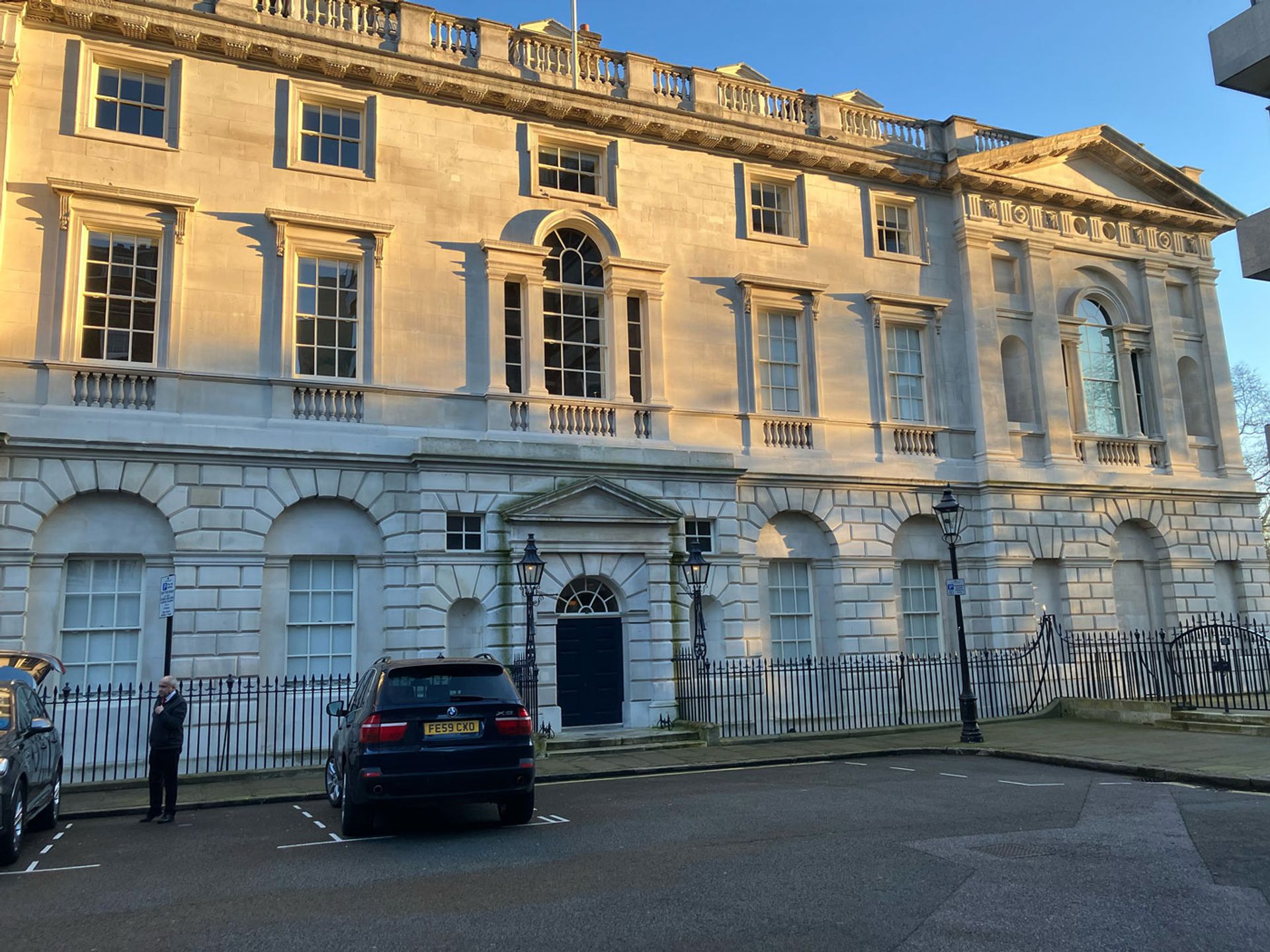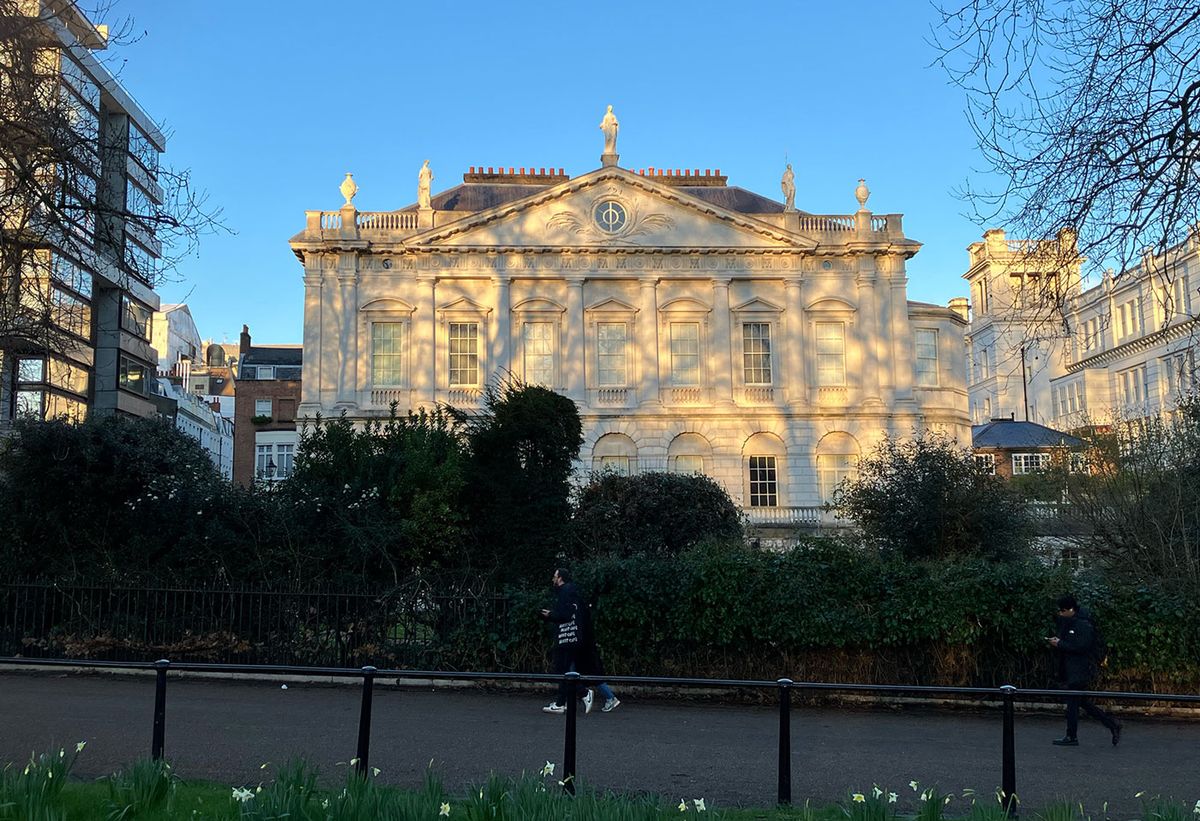Nine years ago Spencer House loomed, leased and neglected, on the edge of Green Park. This Palladian house is the only one of the great aristocratic London town houses still remaining in family hands. A Spencer had not been in residence since 1927, and the suggestion that one return — namely, the newly married Diana, Princess of Wales — failed to find support. In 1985, a twelve-year lease was taken by the investment company J. Rothschild Holdings.
Jacob Rothschild, Chairman of J. Rothschild Holdings and the new tenant, as chairman of the Trustees of the National Gallery, would-be rescuer of Canova’s Three Graces, and White Knight to Spencer House, could be described as a protector of the arts, and one of the richest men of his generation in Britain. Next month, on 19 November, the Princess of Wales will officially unveil the newly restored and refurbished interiors of Spencer House.

The entrance front to Spencer House in 2024 Louis Jebb
Planning permission for office use in perpetuity was granted on the condition that the principal rooms be restored to their 18th-century splendour. The public will be admitted in the summer months, from April to September, on Saturdays and, probably, Sunday afternoons. The meticulous care with which the principal rooms have been returned to something approaching their former glory (unlike those of Somerset House, the new Courtauld Galleries) shows the seriousness of Rothschild’s commitment to the building, but also his political acumen. An advisory committee was formed, consisting of the leading architectural historians Colin Amery, John Cornforth, Gervase Jackson-Stops, John Harris and Peter Thornton. Thus Rothschild ensured both the best possible advice, and silenced his most serious potential critics. The advisory committee decided to take the house back to how it was in the late 18th century, but with some latitude for personal taste over the choice of wall colours. An exact recreation of its interiors is an impossibility because the original furniture and works of art are no longer available. Since 1927, the house has been denuded of virtually every single furnishing, work of art, fixture and fitting.
The meticulous care with which the principal rooms have been returned to something approaching their former glory shows the seriousness of Rothschild’s commitment to the building, but also his political acumen
Almost all the moveable furnishings and pictures were dispatched to Althorp, the Spencer country seat in Northamptonshire, and then, in 1942, all the doorcases and chimney-pieces went too.
There have been no loans from Althorp for Spencer House’s grand refurbishment, although The Queen and the Royal Academy have both seen fit to lend English eighteenth-century paintings. Johnnie Spencer, the 7th Earl Spencer and the princess’s father, has, however, allowed console tables and pier glasses designed by Stuart for the Great Room, and various architectural mouldings, to be copied.
Many important pieces from Spencer House have been sold. What began as a trickle of paintings and furniture leaving Althorp has turned in the last twenty years into a small stream. Works of art have been sold quietly and privately, and arguably not always at the top market value. What makes this a particular tragedy is that fittings and furnishings for Spencer House were designed specifically as part of a detailed decorative scheme in which the picture collection was also integral. The little original furniture which will be returned to the house comes courtesy of the enlightened policy of the Furniture Department of the Victoria and Albert Museum (V&A), then headed by Peter Thornton.
Since the 1970s, Spencer House furniture has been acquired privately or when it came on to the market, with the specific intention of returning it to the house on long loan, should it ever be open to the public on a regular basis. For example, the complete set of seat furniture, designed by Stuart for the Painted Room and supplied in 1759, was offered to the museum by the late Jack Spencer—the 7th Earl, and the princess’s grandfather—in lieu of tax, and acquired in 1977 with the help of the National Art Collections Fund. Two marble-topped, gilt tables supported by winged lions, will return to the Dining Room, one of them from the V&A, the other from Temple Newsam in Leeds. After a 48-piece suite of white-painted and gilt seat furniture designed by John Gordon for the Great Room went to the antique dealers Partridge’s to be restored and re-upholstered, four pieces from it came on to the market.
Two were acquired, unrestored, by the V&A in 1984. It is lending one, and nine will be copied from it. Unsurprisingly, not one of the first Earl Spencer’s 17th-century Italian pictures has returned. The walls of the Great Room, the most imposing of the State Rooms, conceived as a picture gallery as well as a ballroom, are bare, except for a pair of Ciprianis from Houghton, recently purchased at auction.
Flanking one doorcase were Guercino’s King David and his Samian Sybil. Opposite hung Guido Renì’s Liberality and Modesty and Andrea Sacchi’s Apollo Crowning the Musician Marcantonio Pasqualini. The last two had been bought by the first Earl Spencer at the Farnese sale for the then enormous sum of £2,200.
They passed through Wildenstein’s in the 1980s. The Sacchi was sold to the Metropolitan Museum in New York in 1981. The Guido Reni now belongs to Peter Sharp, proprietor of the Carlyle Hotel, New York. The then Director of the National Gallery, Michael Levey, made no objection to their export.
It was obviously deemed unimportant by the National Gallery, if not by the V&A, that both paintings were part of a complete work of art greater than themselves, and that their frames, designed by Stuart, played an integral part in his decorative scheme for the Great Room.


